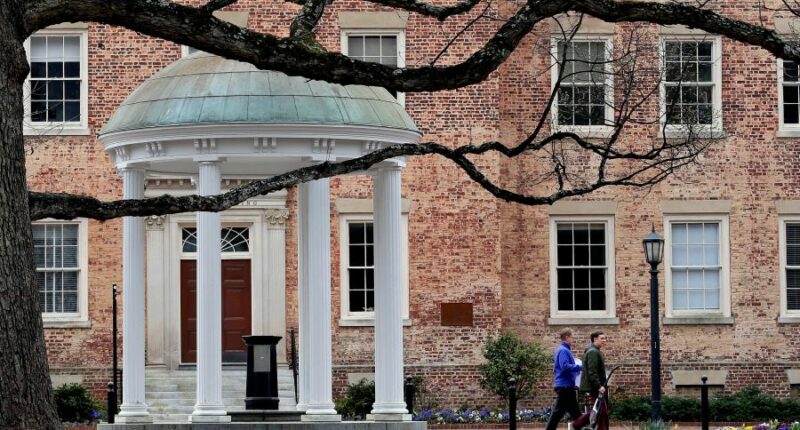Share this @internewscast.com

WASHINGTON (AP) — For today’s youth in America, the decision about which college to attend, or whether to attend at all, has transformed into a detailed evaluation of the financial implications, centering on one pivotal question: Is the degree truly worth the investment?
Recent years have seen a dramatic decline in public trust in higher education, driven by soaring tuition fees, mounting student debt, a challenging job market, and ideological critiques from conservatives. In response, colleges are now working hard to demonstrate their value to potential students.
Adopting a term from the corporate sector, “return on investment” has become a buzzword in college marketing campaigns nationwide. A new wave of rankings evaluates institutions based on the economic advantages they offer. For instance, states like Colorado have begun issuing annual reports on the financial returns of college education, while Texas uses these calculations to help determine the amount of state funding allocated to community colleges.
“Students are increasingly conscious of when a college education may not yield the expected benefits,” noted Preston Cooper, an expert on college ROI at the American Enterprise Institute, a conservative policy institute. “Today, universities are focusing on this issue in a way they weren’t 15 to 20 years ago.”
Most bachelor’s degrees are still worth it
Research consistently shows that obtaining a bachelor’s degree generally offers financial benefits over time. However, there’s an increasing awareness that not every degree guarantees a lucrative career, and even those that appear promising might be less secure due to the current tough job climate.
A recent report from the Strada Education Foundation reveals that 70% of new graduates from public universities are likely to see a positive financial return within a decade—meaning their earnings will surpass those of a typical high school graduate by more than the cost of their education. This percentage varies by location, from 53% in North Dakota to 82% in Washington, D.C. According to the report, states with more affordable college options tend to see better outcomes.
It’s a critical issue for families who wonder how college tuition prices could ever pay off, said Emilia Mattucci, a high school counselor at East Allegheny schools, near Pittsburgh. More than two-thirds of her school’s students come from low-income families, and many aren’t willing to take on the level of debt that past generations accepted.
Instead, more are heading to technical schools or the trades and passing on four-year universities, she said.
“A lot of families are just saying they can’t afford it, or they don’t want to go into debt for years and years and years,” she said.
Education Secretary Linda McMahon has been among those questioning the need for a four-year degree. Speaking at the Reagan Institute think tank in September, McMahon praised programs that prepare students for careers right out of high school.
“I’m not saying kids shouldn’t go to college,” she said. “I’m just saying all kids don’t have to go in order to be successful.”
Lowering college tuition and improving graduate earnings
American higher education has been grappling with both sides of the ROI equation — tuition costs and graduate earnings. It’s becoming even more important as colleges compete for decreasing numbers of college-age students as a result of falling birth rates.
Tuition rates have stayed flat on many campuses in recent years to address affordability concerns, and many private colleges have lowered their sticker prices in an effort to better reflect the cost most students actually pay after factoring in financial aid.
The other part of the equation — making sure graduates land good jobs — is more complicated.
A group of college presidents recently met at Gallup’s Washington headquarters to study public polling on higher education. One of the chief reasons for flagging confidence is a perception that colleges aren’t giving graduates the skills employers need, said Kevin Guskiewicz, president of Michigan State University, one of the leaders at the meeting.
“We’re trying to get out in front of that,” he said.
The issue has been a priority for Guskiewicz since he arrived on campus last year. He gathered a council of Michigan business leaders to identify skills that graduates will need for jobs, from agriculture to banking. The goal is to mold degree programs to the job market’s needs and to get students internships and work experience that can lead to a job.
A disconnect with the job market
Bridging the gap to the job market has been a persistent struggle for U.S. colleges, said Matt Sigelman, president of the Burning Glass Institute, a think tank that studies the workforce. Last year the institute, partnering with Strada researchers, found 52% of recent college graduates were in jobs that didn’t require a degree. Even higher-demand fields, such as education and nursing, had large numbers of graduates in that situation.
“No programs are immune, and no schools are immune,” Sigelman said.
The federal government has been trying to fix the problem for decades, going back to President Barack Obama’s administration. A federal rule first established in 2011 aimed to cut federal money to college programs that leave graduates with low earnings, though it primarily targeted for-profit colleges.
A Republican reconciliation bill passed this year takes a wider view, requiring most colleges to hit earnings standards to be eligible for federal funding. The goal is to make sure college graduates end up earning more than those without a degree.
Others see transparency as a key solution.
For decades, students had little way to know whether graduates of specific degree programs were landing good jobs after college. That started to change with the College Scorecard in 2015, a federal website that shares broad earnings outcomes for college programs. More recently, bipartisan legislation in Congress has sought to give the public even more detailed data.
Lawmakers in North Carolina ordered a 2023 study on the financial return for degrees across the state’s public universities. It found that 93% produced a positive return, meaning graduates were expected to earn more over their lives than someone without a similar degree.
The data is available to the public, showing, for example, that undergraduate degrees in applied math and business tend to have high returns at the University of North Carolina at Chapel Hill, while graduate degrees in psychology and foreign languages often don’t.
Colleges are belatedly realizing how important that kind of data is to students and their families, said Lee Roberts, chancellor of UNC-Chapel Hill, in an interview.
“In uncertain times, students are even more focused — I would say rightly so — on what their job prospects are going to be,” he added. “So I think colleges and universities really owe students and their families this data.”
___
The Associated Press’ education coverage receives financial support from multiple private foundations. AP is solely responsible for all content. Find AP’s standards for working with philanthropies, a list of supporters and funded coverage areas at AP.org.
















